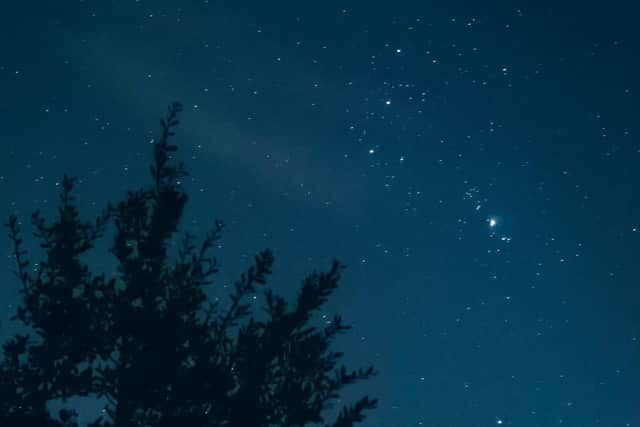How many visible stars were recorded in Blackpool, Wyre and Fylde as light pollution drops during lockdown
and live on Freeview channel 276
CPRE, the countryside charity, said light pollution levels were much lower at the start of 2021 compared to the previous year, and its annual Star Count saw a 10 per cent drop in severe light pollution across Britain.
Residents across the country were asked to participate in the annual count in February, by counting how many stars they could see in the Orion constellation.
Advertisement
Hide AdAdvertisement
Hide AdNearly 8,000 counts were submitted between February 6 and 14 this year, with 51 per cent of people recording ten or fewer stars, indicating severe light pollution.


During the same period last year, 61 per cent of participants noted 10 or fewer.
Some 30 or more stars indicates truly dark skies, and were seen by 5 per cent of participants, the highest figure since 2013.
The charity said lockdown was the most likely reason for this change, with reduced human activity resulting in quieter than usual urban areas.
Advertisement
Hide AdAdvertisement
Hide AdSimilar patterns have been found with air pollution, which has also dropped across the country, it added.
An interactive star map was made available online, which displayed the results of the star count across the UK.
It was a mixed bag of records on the Fylde coast - with both ends of the spectrum - truly dark skies and very severe light pollution - recorded in all three boroughs.
But on average, the number of stars spotted in Blackpool was 17.7 - indicating light pollution.
Advertisement
Hide AdAdvertisement
Hide AdIn Wyre, 15.8 stars were recorded on average, also indicating light pollution, and Fylde's average was recorded as 14 stars - severe light pollution.
Crispin Truman, chief executive of CPRE, the countryside charity, said: "It’s been an absolutely stellar year for Star Count. We had three times as many people taking part compared to previous years and I’m delighted to see severe light pollution in the UK appears to have fallen.
"It’s likely this is an unintended positive consequence of lockdown, as our nighttime habits have changed. Let’s hope we can hold onto some of this achievement as we come out of lockdown.
"Looking up at a starry night sky is a magical sight and one that we believe everyone should be able to experience, wherever they live.
Advertisement
Hide AdAdvertisement
Hide Ad"And the great thing is, light pollution is one of the easiest kinds of pollution to reverse – by ensuring well designed lighting is used only where and when needed, and that there is strong national and local government policy."
How did the star count fare in your area?
Blackpool:
Raleigh Avenue, South Shore: 46 stars counted - truly dark skies
Hawes Side Lane, South Shore: 10 stars counted - severe light pollution
Wasdale Road, Marton: 12 stars counted - light pollution
Mansfield Road, Layton: eight stars counted - severe light pollution
Advertisement
Hide AdAdvertisement
Hide AdBriarwood Drove, Bispham: 16 stars counted - some light pollution
Highcroft Avenue, Bispham: 22 stars counted - fairly dark skies
Allen Close, Anchorsholme: 10 stars counted - severe light pollution
Fylde:
Grenville Avenue, St Annes: four stars counted - very severe light pollution
Advertisement
Hide AdAdvertisement
Hide AdAshworth Road, St Annes: 32 stars counted - truly dark skies
Grange Road, St Annes: eight stars counted - severe light pollution
St David's Road South, St Annes: six stars counted - severe light pollution
Alexandra Road, St Annes: 14 stars counted - light pollution
Advertisement
Hide AdAdvertisement
Hide AdHodgson Avenue, Freckleton: 12 stars counted - light pollution
Derwent Drive, Freckleton: 14 stars counted - light pollution
Memory Close, Freckleton: eight stars counted - severe light pollution
Lodge Close, Freckleton: 14 stars counted - light pollution
Balderstone Road, Freckleton: 58 stars counted - truly dark skies
Advertisement
Hide AdAdvertisement
Hide AdPreston Old Road, Freckleton: 12 stars counted - light pollution
Lowfield Close, Newton: six stars counted - severe light pollution
Long Meadow, Wesham: 10 stars counted - severe light pollution
Teal Close, Wesham: eight stars counted - severe light pollution
Advertisement
Hide AdAdvertisement
Hide AdBleasdale Avenue, Staining: four stars counted - very severe light pollution
Wyre:
Pinewood Avenue, Thornton: 18 stars counted - some light pollution
Stuart Road, Thornton: 14 stars counted - light pollution
Thornton Gate, Cleveleys: 12 stars counted - light pollution
Yew Court, Fleetwood: eight stars counted - severe light pollution
Rydal Road, Hambleton: 46 stars counted - truly dark skies
Advertisement
Hide AdAdvertisement
Hide AdCarr Lane, Stalmine: 16 stars counted - some light pollution
Meadow Avenue, Knott End: 20 stars counted - some light pollution
Derby Crescent, Inskip: two stars counted - very severe light pollution
The Parklands, Catterall: 16 stars counted - some light pollution
Snowhill Lane, Scorton: 10 stars counted - severe light pollution
Hollins Lane, Forton: 12 stars counted - light pollution